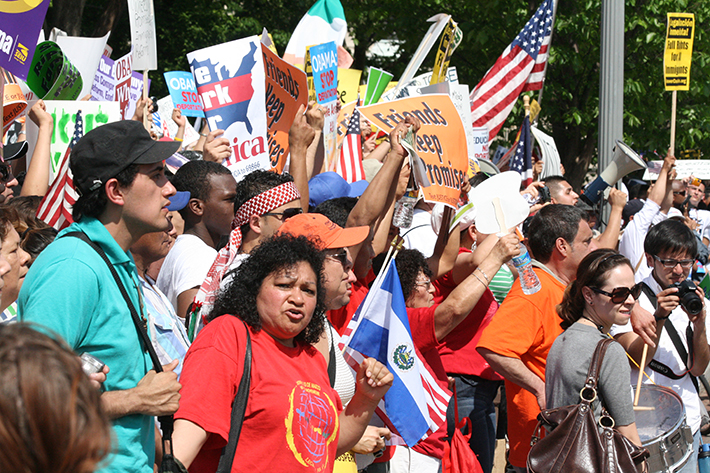Tens of thousands of unaccompanied children have crossed the U.S. border from Central America, overwhelming authorities and reigniting immigration reform debates in Congress. Reports indicate that most of the migrant children come from El Salvador, Honduras and Guatemala—three countries struggling with rampant crime, gang violence and drug cartels.
What to do with these children remains a question. As the Obama administration meets with Central American leaders to talk through potential solutions, three George Washington University experts from international affairs, political and humanitarian backgrounds explain the challenges surrounding the crisis. Professor Cynthia McClintock, associate professor Michael Cornfield and Global Women’s Institute Director Mary Ellsberg discuss how the problem of child refugees is affecting relationships with Central American countries, what steps Congress might take and what can be done to help.
Professor of International Affairs Cynthia McClintock: Central America’s intense violence has provoked the immigration crisis.

“The immigration crisis is provoked by the intense violence in Honduras, Guatemala and El Salvador. All three countries are wracked by drug-trafficking gangs that take advantage of the weakness of the security forces. Gangs prey on citizens and try to recruit young people to their ranks.
Coyotes, or guides who help smuggle immigrants across the border, have reaped thousands of dollars per migrant—successful or not. They have spread the word that minors who arrive in the U.S. from these countries are entitled to due process, and minors undertake the journey without full knowledge of the perils. Two other Central American countries, Costa Rica and Nicaragua, are slightly further from the U.S. border and citizen security is much better; accordingly, immigration flows are much less.
In their meeting on July 25, President Obama and the three Central American presidents agreed on the causes of the immigration crisis and on efforts for its mitigation, but to date, President Obama's request for additional funds has not been approved by the U.S. Congress.”
Political Management Associate Professor Michael Cornfield: Chronic partisan struggle, executive and legislative faceoff complicate border crisis.

"Two deep political disputes complicate the fate of the child refugees in detention at the U.S.-Mexico border.
The first is the chronic partisan struggle for greater control of the national government. Democrats want to preserve their electoral advantage with Hispanic voters by pressing for comprehensive immigration reform; this drive entangles the processing of the children in larger issues about who rightly qualifies for jobs and benefits during an economic downturn. Republicans want to cut into the Democratic advantage through piecemeal reforms, and they want to delay such actions until the next Congress begins in 2015, because they believe that they will control the Senate as well as the House at that time.
The second dispute is the classic Constitutional faceoff between the executive and legislative branches. The Obama White House has claimed authority to act unilaterally on aspects of the immigration issue, and may yet extend that claim to encompass this situation. For now, however, the administration has put the ball in Congress’s court, saying that it cannot process the children any faster, fairer or differently because it is bound by laws which happen to have been passed by bipartisan majorities during the Bush administration. Meanwhile, House Speaker John Boehner and other Republican voices have thematized Obama’s executive overreach across several issues, including immigration. They contend that the record shows they cannot trust the president to act within the confines of the law, or competently even, when it does stick to the law.
There may yet be a bipartisan executive-legislative deal to relieve this humanitarian agony, as there was after Hurricane Sandy. Then again, these children can’t vote or make campaign donations and expenditures. Since they lack any leverage on the political process, their futures, the future of U.S. immigration policy and future control of the national government are entwined so thoroughly as to make it impossible to predict what will happen next, let alone in the years to come.
Global Women’s Institute Director Mary Ellsberg: Children and families deserve U.S. support and protection.

“One dimension of this humanitarian crisis has hardly been mentioned in the current debate: El Salvador, Honduras and Guatemala have among the highest rates of gender-motivated killing of women in the world. Some of these murders are gang-related, but a large number of women are murdered by their husbands or partners, and these crimes are rarely investigated and even more rarely punished. Many women and girls are willing to risk the incredible hardship and danger of the journey to the border because they believe it is their only chance for survival.
According to a study by the United Nations High Commissioner for Refugees (UNHCR), 24 percent of the immigrant girls detained at the border mentioned their fear of being raped and 40 percent mentioned violence at home as their main reasons for crossing into the United States. UNHCR estimates that as many as 60 percent of the unaccompanied children could be in need of international protection.
These children and their families deserve our support and our protection. Deporting them without due process is not only morally reprehensible, but it is also a violation of our international human rights obligations.”


